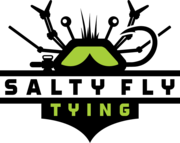I seems like every time you go to buy fly tying materials there are more and more materials on the shelves with the letters “UV” somewhere on the label. Over the last few year, I have spent a lot of time researching ultraviolet (UV) materials and the hubbub surrounding them. Experimenting with my war chest of materials both at the bench and on the flats I have made some pretty interesting discoveries in relationship to a materials visibility underwater.
This is the fifth installment of Feather Brain by Drew Chicone. To read more about UV Reflective and Reactive Materials ,Visit my website Salty Fly Tying to order your signed copy of Feather Brain today! $24.95 + Shipping
Most but not all feathers are UV reflective, and the color of the plumage plays a large role. White feathers are highly UV reflective while darker or black feathers are less reflective or not reflective at all. Synthetic materials that are bright colors like chartreuse are considered UV Reactive, because they light up when you shine a UV light on them.
Over the next few months I will give you the basics on designing your own patterns, tying with saltwater materials, and fixing typical problems. I will also discuss my process for Developing, Testing, and Improving Saltwater Fly Patterns . As always, you can stay tuned to this blog each week as I share pieces from my book, but for the complete 176 page paperback copy of Feather Brain with step-by-step tying instructions and explanations of how I designed my 14 winning saltwater flies, and insights from nine top saltwater fly tiers, including Bob Clouser, Jonny King, Bob Popovics, and Chris Helm and many more.
Here’s what the pro’s are saying about Feather Brain:


